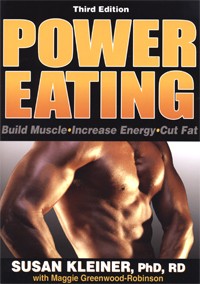Power Eating, 3rd ed.
|

|
| Author: |
Kleiner S, Greenwood-Robinson M |
| Category: |
Sports Nutrition |
| Audience: |
Elite Athlete |
| Length: |
314 pages |
| Publisher: |
Human Kinetics |
| Year Published: |
2007 |
| List Price: |
$16.95 |
|
|
|
|
AthleteInMe.com®
Rating:


 Good
Good
This is the 3rd edition of Power Eating, an update of the 2nd edition which was published in 2001.
Recommended for: Body-builders, weight-lifters, and strength-training athletes.
ABOUT THE AUTHORS
• Susan Kleiner holds a PhD in nutrition and human performance from Case Western Reserve. She is also a registered dietician and serves as a consultant for GNC and the Seattle SuperSonics. • Maggie Greenwood-Robinson holds a PhD in nutrition counseling from LaSalle University. She has authored or co-authored 19 books in the health and fitness field.
CONTENT
The 314-page text contains 16 chapters as follows:
PART I: FOUNDATION
- Chapter 1: Eating for Power
- Chapter 2: Manufacturing Muscle
- Chapter 3: Fueling Workouts
- Chapter 4: Managing Fat
- Chapter 5: Burning Fat
- Chapter 6: Hydrating for Heavy-Duty Workouts
PART II: SUPPLEMENTS
- Chapter 7: Vitamins and Minerals for Strength Trainers
- Chapter 8: Muscle-Building Products
- Chapter 9: Performance Herbs
PART III: PLANS and MENUS
- Chapter 10: Developing a Power Eating Plan
- Chapter 11: Planning a Peak
- Chapter 12: Maintaining Physique Menu Plans
- Chapter 13: Building Muscle Menu Plans
- Chapter 14: Losing Fat Menu Plans
- Chapter 15: Getting Cut Menu Plans
- Chapter 16: Power Eating Recipes
REVIEW
In general, the book is easy to read, with ample numbers of tables and
black-and-white photographs. The book is based on solid scientific research. There is a list of cited references at the end of the book that is 18 pages long. Unfortunately, to avoid bogging down the reader by citing the references throughout the text, specific statements cannot be attributed to their original source.
Part II consists of three chapters (82 pages) that are devoted to vitamins/minerals, sports supplements, and "performance" herbs. Generally, this information is good. The chapters on Muscle-Building Products and Performance Herbs are subdivided into "Definitely Worth It", "Possibly Useful", "Wasting Your Time", and "Potentially Harmful". The authors are to be commended for attempting to shed some perspective on the dubious world of sports supplements, however, these chapters would be stronger if citations back to the original sources were provided in the text.
• What I Liked About The Book: Both authors hold PhD degrees. They bring a solid scientific (evidence-based) approach to what they write. Indeed, as mentioned above, hundreds of research citations are included in their references list.
• What Could Be Better: Provide the specific source of the research directly following the statement to which it applies. Although this book is intended for consumers, not academics, some readers may want to take advantage of the comprehensive literature review that the authors provide.
SUMMARY
Power Eating is a good reference for the strength-training athlete who does not want a more academically-written text.
NOTE: An updated version of this book -- "The New Power Eating" -- was released in September 2018. Look for a review soon!
Copyright ©2008 AthleteInMe, LLC. All rights reserved.
| Reviewed by: Stan Reents, PharmD |
9/26/2018 8:15:19 AM |
|